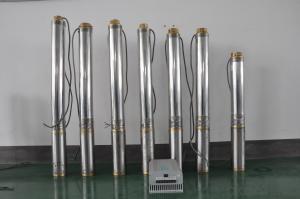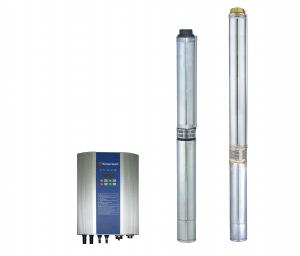Solar Water Pump L3D-07-250
- Loading Port:
- China Main Port
- Payment Terms:
- TT OR LC
- Min Order Qty:
- -
- Supply Capability:
- 300 sets /month
OKorder Service Pledge
OKorder Financial Service
You Might Also Like
Product description:
Product: Solar water pump
Model:L3D-07-250

Appilication:
surface pump
for surface water of pond, river, lake
for irrigation of a big farm with 4000 m2 on the top of a high mountain
Product specification:
flow rate:7m3/ hour, 56m3/day.
lift: 10m-250m
pump diameter: 296mm
Pump installed on the ground, outlet to the water surface:4m
with AC motor, motor power:5.5kW
but only need solar power:5.2kW(while Grundfos pump needs at least 18.5kW solar power, our pump can save more than 70% solar panel power,save USD8000 cost for solar panel per set.
Material:
Pump inside: stainless steel and wearable nylon,it enables our solar pump to have 10 years sevice life.
Motor : AC motor, 380V , three phase , 50Hz. The pump also can connect with grid power directly.
Certification:
3 International patent
ISO9001
CE
Warranty:2 years
- Q:Can a solar pump be used for water purification purposes?
- Yes, a solar pump can be used for water purification purposes. Solar pumps can be used to extract water from various sources such as wells, rivers, or lakes. This water can then be treated or purified using appropriate water purification techniques such as filtration, UV sterilization, or chemical disinfection. The use of solar energy to power the pump ensures a sustainable and environmentally friendly solution for water purification.
- Q:Are there any limitations to the size of the solar pump system that can be installed?
- Yes, there are some limitations to the size of the solar pump system that can be installed. One limitation is the availability of space for installation. Solar pump systems require a sufficient area with good sunlight exposure to install the solar panels. If there is limited space or if the available space is shaded, it may not be possible to install a large solar pump system. Additionally, the capacity of the solar panels to generate electricity limits the size of the pump system. The size of the solar panels determines the amount of power that can be produced, and this power is used to operate the pump. If the solar panels have a lower capacity, it will limit the size of the pump system that can be installed. Another limitation is the water source and the amount of water that needs to be pumped. The solar pump system needs to be matched with the water demand and the capacity of the water source. If the water demand is high or the water source has limited capacity, it may not be feasible to install a large solar pump system. Lastly, budget constraints can also limit the size of the solar pump system. Larger systems generally require more solar panels, batteries, and other components, which can increase the cost. If there is a limited budget, it may not be possible to install a larger system and a smaller pump system would be more suitable. Overall, while solar pump systems offer a sustainable and efficient solution for pumping water, there are limitations to their size due to space availability, solar panel capacity, water source, and budget constraints. It is important to carefully assess these factors before determining the size of the solar pump system to be installed.
- Q:Are there any restrictions on using a solar pump in agriculture?
- Yes, there can be certain restrictions on using a solar pump in agriculture. Some potential limitations include the availability of sunlight, which can affect the efficiency of the pump, especially in regions with frequent cloudy or rainy weather. Additionally, the initial cost of installing a solar pump can be higher compared to traditional pumps, which may pose financial constraints for some farmers. It is also important to consider the size and capacity of the solar pump, as it may not be suitable for large-scale irrigation needs.
- Q:How does the tilt angle of the solar panel affect the performance of a solar pump?
- The tilt angle of a solar panel affects the performance of a solar pump by directly impacting the amount of sunlight it receives. A properly tilted solar panel can maximize the absorption of sunlight, leading to increased energy production and improved pump performance. On the other hand, an incorrect tilt angle can reduce the efficiency of the solar panel, resulting in lower energy output and decreased pump performance.
- Q:Are there any limitations on the water pressure that can be achieved with a solar pump?
- Yes, there are limitations on the water pressure that can be achieved with a solar pump. The maximum water pressure achievable depends on various factors such as the design and power of the solar pump, the height and distance the water needs to be lifted, and the capacity of the solar panels. Additionally, the availability of sunlight and the efficiency of the pump's components can also impact the water pressure.
- Q:How to use solar panels to drive 50W of circulating water pump, what configuration needs, how to connect?
- But you may have doubts, the current is big, the opportunity will not be easy to burn out, I give an example: the battery current is like the car's seat, people metaphor for the load, the motor rated power unchanged
- Q:How does a solar pump handle water with high alkalinity?
- A solar pump can handle water with high alkalinity by using a combination of filtration and chemical treatment methods. The filtration system removes any suspended particles or impurities from the water, while the chemical treatment neutralizes the alkalinity levels. This ensures that the water pumped by the solar pump is suitable for various applications without any adverse effects from high alkalinity.
- Q:What is the energy efficiency of a solar pump compared to traditional pumps?
- The energy efficiency of a solar pump compared to traditional pumps is generally higher. Solar pumps utilize the sun's energy to power the pump, eliminating the need for electricity or fuel consumption. This makes them more environmentally friendly and cost-effective in the long run. Traditional pumps, on the other hand, often rely on electricity or fossil fuels, which can be expensive and contribute to carbon emissions. Solar pumps also have the advantage of being self-sufficient and independent of the grid, making them suitable for remote areas or locations with limited access to electricity. Additionally, solar pumps are designed to be highly efficient, with advanced technology and smart controls that optimize energy usage and minimize wastage. Overall, solar pumps offer a greener and more efficient alternative to traditional pumps.
- Q:Can a solar pump be used for water supply in remote oil rigs?
- Yes, a solar pump can be used for water supply in remote oil rigs. Solar pumps are a viable and sustainable solution for water supply in remote locations, as they can operate efficiently using solar energy. They eliminate the need for grid connection or fuel-powered pumps, reducing costs and environmental impact. Additionally, solar pumps can provide a reliable water supply, ensuring the smooth operation of oil rigs in remote areas.
- Q:Can a solar pump be used in areas with limited access to water purification?
- Yes, a solar pump can be used in areas with limited access to water purification. Solar pumps are specifically designed to draw water from various sources such as wells, rivers, and lakes. Although the water may not be purified, it can still be used for various purposes like irrigation, livestock watering, and household needs. However, it is important to note that for safe drinking water, additional purification methods should be employed to ensure water quality.
1. Manufacturer Overview |
|
|---|---|
| Location | |
| Year Established | |
| Annual Output Value | |
| Main Markets | |
| Company Certifications | |
2. Manufacturer Certificates |
|
|---|---|
| a) Certification Name | |
| Range | |
| Reference | |
| Validity Period | |
3. Manufacturer Capability |
|
|---|---|
| a)Trade Capacity | |
| Nearest Port | |
| Export Percentage | |
| No.of Employees in Trade Department | |
| Language Spoken: | |
| b)Factory Information | |
| Factory Size: | |
| No. of Production Lines | |
| Contract Manufacturing | |
| Product Price Range | |
Send your message to us
Solar Water Pump L3D-07-250
- Loading Port:
- China Main Port
- Payment Terms:
- TT OR LC
- Min Order Qty:
- -
- Supply Capability:
- 300 sets /month
OKorder Service Pledge
OKorder Financial Service
Similar products
New products
Hot products
Hot Searches
Related keywords

























